Climate modelling
Key Information
In order to understand how our climate might change in the future, scientists need tools to measure how the Earth responds to change. Climate models provide scientists with a means of projecting future climate conditions and provide the information that we need to plan for the future in terms of economic, social and environmental considerations.
Climate projections for the next century indicate that the climate trends observed over the last century will continue and intensify over the coming decades. We can expect future changes in climate to be far greater than anything we have seen in the past.
- Climate models are mathematical representations of the global climate system and are essential for providing society with fundamental information on potential changes in future climate;
- The modelling of future climate is a complex procedure. To help us understand how future climate might change, estimates of future levels of emissions must be made and these are based on assumptions about future economic, societal and environmental changes;
- In projecting future climate, climate models use a wide range of scenarios or storylines to simulate how climate might change under different trajectories of future GHG emissions. These trajectories are based on projections of social, economic and technological development;
- Due to the uncertain factors (e.g. future population growth), the complexity of the climate system and computational limitations, there remains considerable uncertainty surrounding projections of future climate;
- Nonetheless, climate models provide us with the best available information on how our climate might change into the future.
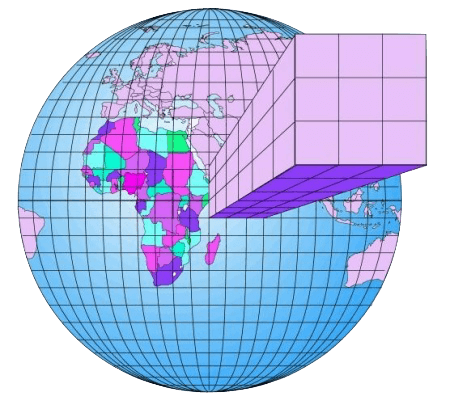
General Circulation Models (GCMs)
Climate models are first developed on a global scale, General Circulation Models (GCMs), and are mathematical representations of the global climate system. Before projections of future climate are made, these models are first tuned to simulate the current climate and are only used to project how the climate might change in the future once they can accurately depict current climate.
Detailed explanation
Similar to the way in which an architect might build a scale model of a building to understand and predict its behaviour, climate scientists build computer-based models of the climate system to understand and predict the its behaviour. These models provide us with information on how climate might change in the future and this information is essential for providing society with the fundamental information to allows for more effective policy-making and planning.
The extent of future climate change will depend on several factors:
- Ongoing and future levels of emissions of GHG;
- The response of the climate system to changes in GHG concentrations;
- Natural influences (e.g. volcanic activity) and natural processes (e.g. changes in oceanic circulation patterns).
Estimating levels of future greenhouse gas emissions and concentrations
When projecting future climate, estimations of future levels of emissions of greenhouse gases and subsequent atmospheric concentration are required. As it is difficult to estimate future levels of emissions, scientists use various assumptions about how changes in future economic, social, technological and environmental conditions might unfold and, on this basis, develop future emission scenarios/storylines.
Emission Scenarios
Emission scenarios describe how levels of GHG emissions could evolve in the future and the consequences of these for atmospheric GHG concentrations. These scenarios are essential for climate models and allow scientists to compare the results of climate models under different levels of future GHG emissions
Previously (as part of the IPCC’s Fourth Assessment Report (AR4)), estimating future levels of emissions was handled using the Special Report on Emissions Scenarios (SRES). Most recently, and as part of the IPCC’s Fifth Assessment Report (AR5), Representative Concentration Pathways (RCP) scenarios have been employed.
Special Report on Emissions Scenarios (SRES)
These estimates were based on estimated future changes in levels of emissions, changes in land use and other relevant factors. On this basis, four narrative storylines were developed and labelled A1, A2, B1 and B2. In simple terms, the four storylines combine two sets of divergent tendencies: one set varying between strong economic and environmental values, the other between increasing globalisation and regionalisation.
Representative Concentration Pathways (RCPs)
RCPs focus on radiative forcing – the change in balance between incoming and outgoing radiation caused mainly by changes in atmospheric composition rather than being linked to any specific combination of socioeconomic and technological development scenarios. Four different RCPs have been developed (RCP2.6, RCP4.5, RCP6.0 and RCP8.5) to represent a broad range of climate outcomes and are defined by their total radiative forcing (cumulative measure of human emissions of GHGs from all sources, expressed in Watts per square metre).
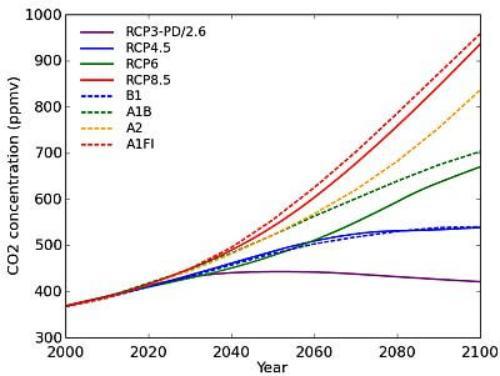
Comparison of SRES and RCP Carbon Dioxide concentrations. Note the use of Carbon Dioxide equivalent concentrations [source: Meinshausen et al., 2011].
Shared Socioeconomic Pathways (SSPs)
SSPs focus on the socioeconomic factors that lead to anthropogenic emissions and modelling how these could change over the coming century. These then produce five models of potential emissions futures and can be combined with the RCPs for more in-depth models of potential climate mitigations. The five SSPs are:
- SSP1: Sustainability (taking the green road)
- SSP2: Middle of the road
- SSP3: Regional rivalry (a rocky road)
- SSP4: Inequality (a road divided)
- SSP5: Fossil-fueled development (taking the highway)
However, it is highly unlikely that any single emission path will occur as described in a single scenario. As a result, a set of scenarios are generally employed, each making different assumptions for greenhouse gas emissions. This is referred to as a multi-model approach, which aims to represent the current range of uncertainty surrounding future levels of emissions.
Climate models
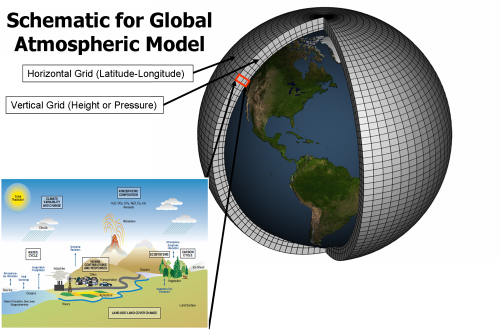
Global Climate Models (GCMs) are mathematical representations of the global climate system. The globe is divided into a horizontal and vertical grid. For each cell, GCMs try to simulate as much as possible about the climate system and how they interact with each other.
However, despite the sophistication and complexity of GCMs, the output from these models is generally too coarse to be effectively employed in assessing regional or local impacts. This is because of the high computational requirements of GCMs. In order to overcome these issues, regionalisation or down-scaling of GCM outputs is often required.
Regionalising projected climate information
In order to make projected climate information developed through GCMs of use at national and regional levels, it is essential that the relative coarse spatial resolution of GCMs (e.g. 125km), which tends to wash out some of the detail, is downscaled to a finer grid. This involves linking Regional Climate Models (RCMs) to a global climate model to provide more detailed analyses of local conditions. This is because RCMs examine only a small portion of the globe and as a result can operate at a much higher spatial resolution and with more detailed topography and parameterisations. For Ireland, down-scaling of GCMs to regional scale has been achieved using two approaches: statistical downscaling of the outputs of a GCM and dynamic downscaling which fits outputs from GCM into a regional climate model (RCM).
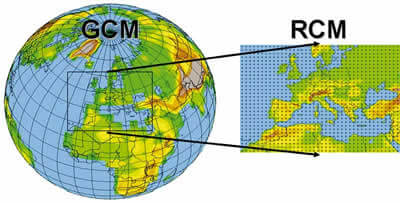
RCM vs GCM
Regional climate models (RCM) are nested within a global climate model (GCM). Due to the computational requirements of developing climate projections for the entire globe, the spatial resolution of the GCM is relatively large. RCMs model climate for limited areas; as a result, the spatial resolution of the model is relatively high compared to GCMs and information such as detailed topography can be included.
Sources of uncertainty in climate model projections
Modelling future climate conditions is a complex procedure and although significant advances in modelling chaotic behaviour and natural variability in the climate system have been made as technologies and techniques have been developed, climate modelling is not an exact science and it must be recognised that climate models will not be able to provide a singular projection of future climate. This is because models cannot capture all the factors involved in a natural system and those that they do capture are not always completely understood. In addition, one of the first inputs into any climate model is expected accumulation of greenhouse gases and aerosols in the atmosphere by the end of the century. These accumulations are based on economic models that predict fossil fuel use over the next 100 years - however, as the economic collapse of 2008 highlights, it is very difficult to predict change in the economy.
Importantly, none of these uncertainties make climate models useless: the present models are clearly able to reproduce natural climate variability over the last 150 years and have been essential in providing the theoretical link between CO2 and global temperatures. The vision of the future generated by climate models has remained incredibly stable from the first generation of climate models to the most recent. Although greater knowledge and improved models will always be desirable, we must begin to act now and embrace the uncertainties evident in current climate models within our decision-making processes.
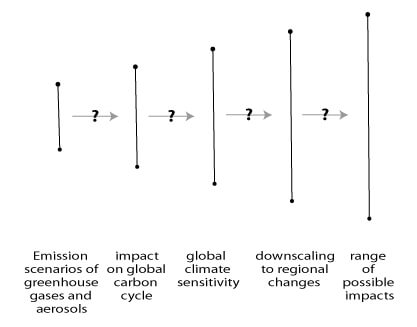
Uncertainty cascade: the range of typical uncertainties that are common in climate change impact assessments.
Resources
- NASA - Science Brief: The Physics of Climate Modelling: In this page, NASA provides an overview of the basic physics around climate modelling.
- NOAA - How reliable are the models used to make projections of future climate change: In this page, the National Oceanographic and Atmospheric Association (NOAA) provides an assessment of the validity in employing climate models to project future climate.
- RCP Database - RCPs Characteristics and Guidance: The RCP database aims at documenting the emissions, concentrations, and land-cover change projections of the so-called "Representative Concentration Pathways" (RCPs).
- IPCC Special Report: Emissions Scenarios - Summary for Policy Makers: This report details the SRES scenarios of future emissions as employed in the projection of future climate.
- SSP Database - SSP Characteristics and Guidance: The SSP database aims at documenting the emissions, concentrations, and land-cover change projections of the so-called Shared Socioeconomic Pathways (SSPs) and related Integrated Assessment scenarios.
